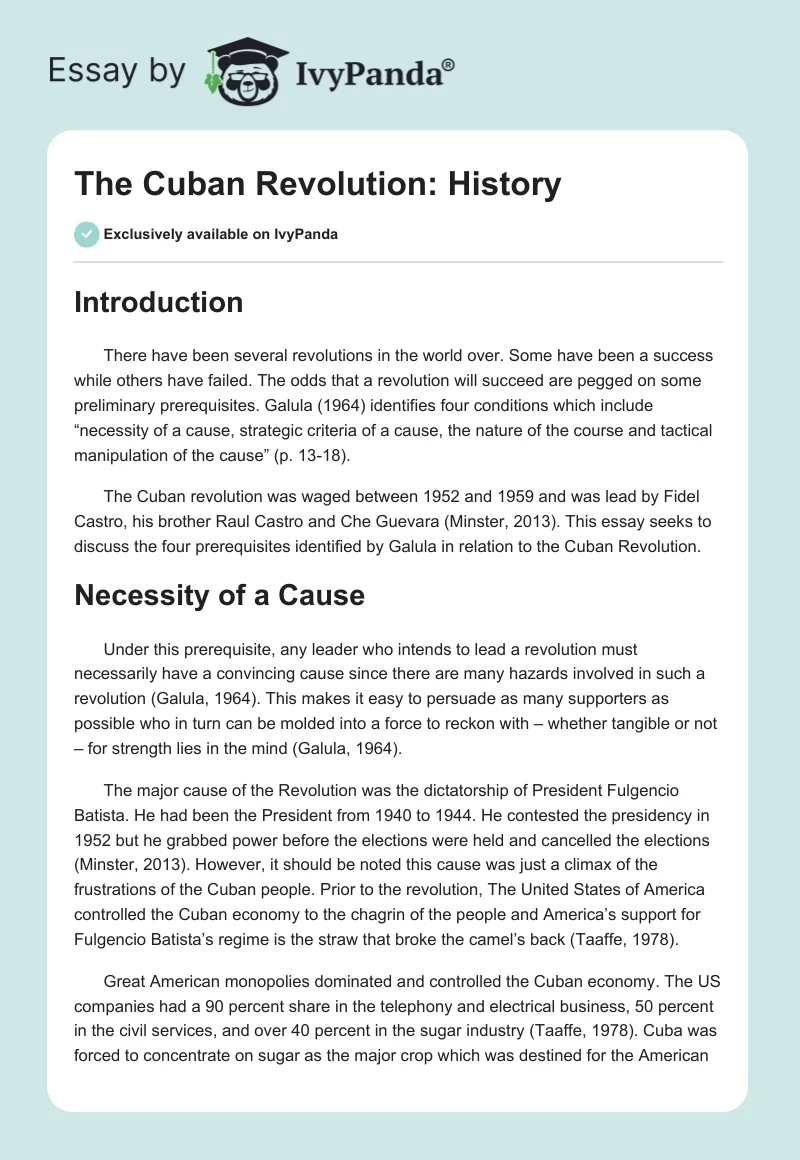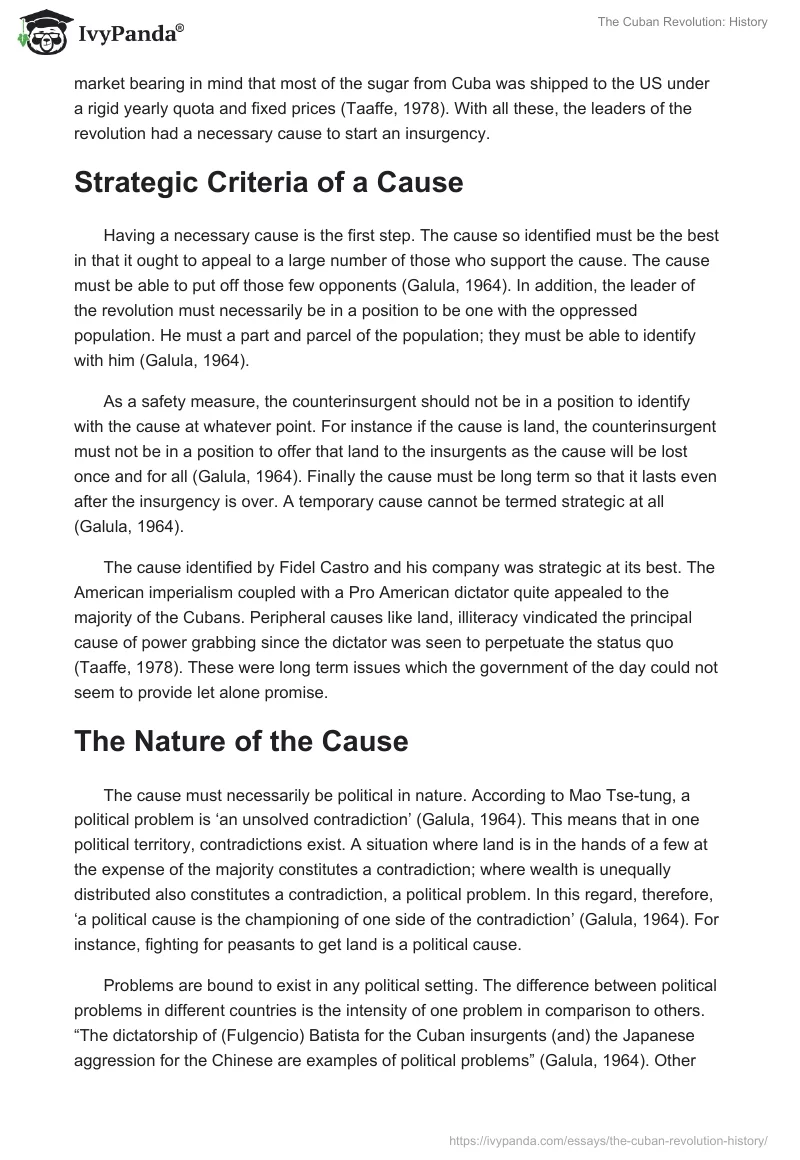Introduction
There have been several revolutions in the world over. Some have been a success while others have failed. The odds that a revolution will succeed are pegged on some preliminary prerequisites. Galula (1964) identifies four conditions which include “necessity of a cause, strategic criteria of a cause, the nature of the course and tactical manipulation of the cause” (p. 13-18).
The Cuban revolution was waged between 1952 and 1959 and was lead by Fidel Castro, his brother Raul Castro and Che Guevara (Minster, 2013). This essay seeks to discuss the four prerequisites identified by Galula in relation to the Cuban Revolution.
Necessity of a Cause
Under this prerequisite, any leader who intends to lead a revolution must necessarily have a convincing cause since there are many hazards involved in such a revolution (Galula, 1964). This makes it easy to persuade as many supporters as possible who in turn can be molded into a force to reckon with – whether tangible or not – for strength lies in the mind (Galula, 1964).
The major cause of the Revolution was the dictatorship of President Fulgencio Batista. He had been the President from 1940 to 1944. He contested the presidency in 1952 but he grabbed power before the elections were held and cancelled the elections (Minster, 2013). However, it should be noted this cause was just a climax of the frustrations of the Cuban people. Prior to the revolution, The United States of America controlled the Cuban economy to the chagrin of the people and America’s support for Fulgencio Batista’s regime is the straw that broke the camel’s back (Taaffe, 1978).
Great American monopolies dominated and controlled the Cuban economy. The US companies had a 90 percent share in the telephony and electrical business, 50 percent in the civil services, and over 40 percent in the sugar industry (Taaffe, 1978). Cuba was forced to concentrate on sugar as the major crop which was destined for the American market bearing in mind that most of the sugar from Cuba was shipped to the US under a rigid yearly quota and fixed prices (Taaffe, 1978). With all these, the leaders of the revolution had a necessary cause to start an insurgency.
Strategic Criteria of a Cause
Having a necessary cause is the first step. The cause so identified must be the best in that it ought to appeal to a large number of those who support the cause. The cause must be able to put off those few opponents (Galula, 1964). In addition, the leader of the revolution must necessarily be in a position to be one with the oppressed population. He must a part and parcel of the population; they must be able to identify with him (Galula, 1964).
As a safety measure, the counterinsurgent should not be in a position to identify with the cause at whatever point. For instance if the cause is land, the counterinsurgent must not be in a position to offer that land to the insurgents as the cause will be lost once and for all (Galula, 1964). Finally the cause must be long term so that it lasts even after the insurgency is over. A temporary cause cannot be termed strategic at all (Galula, 1964).
The cause identified by Fidel Castro and his company was strategic at its best. The American imperialism coupled with a Pro American dictator quite appealed to the majority of the Cubans. Peripheral causes like land, illiteracy vindicated the principal cause of power grabbing since the dictator was seen to perpetuate the status quo (Taaffe, 1978). These were long term issues which the government of the day could not seem to provide let alone promise.
The Nature of the Cause
The cause must necessarily be political in nature. According to Mao Tse-tung, a political problem is ‘an unsolved contradiction’ (Galula, 1964). This means that in one political territory, contradictions exist. A situation where land is in the hands of a few at the expense of the majority constitutes a contradiction; where wealth is unequally distributed also constitutes a contradiction, a political problem. In this regard, therefore, ‘a political cause is the championing of one side of the contradiction’ (Galula, 1964). For instance, fighting for peasants to get land is a political cause.
Problems are bound to exist in any political setting. The difference between political problems in different countries is the intensity of one problem in comparison to others. “The dictatorship of (Fulgencio) Batista for the Cuban insurgents (and) the Japanese aggression for the Chinese are examples of political problems” (Galula, 1964). Other than political problems, problems may be social as when a certain class takes advantage of a lower class, or economical as when the cost of living shoots up.
There existed a political problem in Cuba: the dictatorship of Batista. It is reported that over 20,000 citizens had died through tortures by his soldiers (Taaffe, 1978). This happened between 1953 and 1959. He was also opposed to land re distribution, introduction of democracy besides siding with foreigners to fleece Cuba (Taaffe, 1978).
Tactical Manipulation of the Cause
As long as a cause has been identified, the leader of the insurgency can rally more causes to the chief cause so that more people get attracted and support the insurgency. A single cause might not appeal to all groups in the society and hence the need to shop for more causes (Galula, 1964). For instance, the leader of the insurgency might look for example to exploit the land issue to appeal to the peasants, the issue of unfair taxes to the rich farmers and lack of jobs for the youth.
The Cuban revolution was “a beacon of struggle and resistance against American imperialism for millions of workers, poor peasants and youth…” (Rey, 2002). This shows that the leaders of the insurgency were able to appeal to different groups with different causes joined to the main cause of dictatorship. The dictatorship was synonymous with the American imperialism since Batista had been propped up by the Americans (Taaffe, 1978).
This partly explains why Fidel Castro and company were able to fight against the mighty army of Batista. The peasants, the youths and the rich alike fought alongside the revolution leaders. In fact most of the soldiers left Batista and joined the revolution (Minster, 2013).
Conclusion
The Cuban revolution vindicates Galula’s theory that for an insurgency to be successful, several conditions have to be met. The revolution, staged by Fidel Castro in conjunction with Raul Castro and Che Guevara succeed because the four prerequisites – necessity of cause, strategic criteria of a cause, the nature of the cause and tactical manipulation of the cause – were all at play and well articulated.
References
Galula, D. (1964). Counter-Insurgency Warfare: Theory and Practice. London: Frederick A. Praeger, Inc.
Minster, C. (2013). The Cuban Revolution. Web.
Rey, D. (2002). The Cuban Revolution at the Crossroads. Web.
Taaffe, P. (1978). Cuba: Socialism and Democracy. Web.


